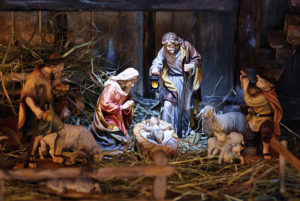From the Desk of Pastor Mech
Prepare to share glad tidings of comfort and joy, of a Savior who has been born to us, who is Christ, the Lord!
Our Advent and Christmas focus will be shaped by a familiar Christmas hymn. The author of the series, Rev. Ralph Tausz, provides the context:
 The birth of a certain child two thousand years ago in Bethlehem prompted a poet in the nineteenth century to ask a very un common question in a hymn: “What Child Is This?” It was an uncommon question because it asked about the birth of a very uncommon child.
The birth of a certain child two thousand years ago in Bethlehem prompted a poet in the nineteenth century to ask a very un common question in a hymn: “What Child Is This?” It was an uncommon question because it asked about the birth of a very uncommon child.
What Child Is This? The angel who announced this child’s birth on Christmas Eve answered the question this way: “A Savior, who is Christ the Lord.” The hymnwriter answered it this way: “This, this is Christ the king.” They both want to make known the identity of this child.
The goal of this series is to set before the hearer the unmatched blessing of the Lord’s incarnation. Our hymn helps us in this regard by making connections that we might not otherwise make. The sermon series draws upon the themes of Holy Scripture and teaches us to appreciate the full range of blessings that are ours through faith in the child who is God from before the foundations of the world, and who was born of the Virgin Mary. Confronted and comforted by this reality, with penitent and hope-filled hearts, we join to sing:
“Haste, haste to bring Him laud, Hail, hail the Word made flesh,” and “Joy, joy, for Christ is born, The babe, the son of Mary!”
Behold, your king is coming to you. -Matthew 21:5
Like the season of Lent, Advent affords the penitent a time of preparation for celebrating the fulfillment of the Father’s plan of salvation in the incarnation of His Son, Jesus. Though Advent is not as “deep” as the preparatory season of Lent, the Church does exercise some restraint in the Divine Service during Advent.
 Advent is the first season in the “Time of Christmas.” The calendar of the Church begins with Advent (from Latin adventus, which means “coming into”), a four-week period of preparation before Christmas. The Savior’s birth is second in importance only to His resurrection on Easter Sunday.
Advent is the first season in the “Time of Christmas.” The calendar of the Church begins with Advent (from Latin adventus, which means “coming into”), a four-week period of preparation before Christmas. The Savior’s birth is second in importance only to His resurrection on Easter Sunday.
Traditionally, Advent encompasses a spiritual preparation for the celebration of the Nativity of Jesus Christ at Christmas. The Western Church sets the season of Advent as beginning on the fourth Sunday prior to Christmas Day, or the Sunday that falls closest to November 30, and lasting through the daytime services of December 24. Christmas begins with the evening services (Vigil) on December 24 and extends through the twelve days of Christmas. The Christmas octave (eight days) includes the Nativity on December 25; Feast of St. Stephen, the first Martyr, on December 26, the day after Christmas; the Feast of St. John, Apostle and Evangelist, on December 27; the Feast of the Holy Innocents on December 28; and the Festival of the Circumcision and Name of Jesus on January 1.
The Son of God became a man to enable men to become sons of God. -C. S. Lewis, Mere Christianity
The Christmas season follows as the fulfillment of the Advent expectation. The long-expected first coming (the Nativity) and birth in Bethlehem is the promise and guarantee of the second and final coming on the Last Day.
Christmas is the celebration of the victory of the True Light born into the world dark in sin. God Himself visits us in our darkness. Heaven and earth are to be renewed by God’s coming.
The Gloria in Excelsis is the preferred Hymn of Praise. The restraint that characterized Advent is lifted. Second only to Easter, Christmas is observed in great joy and with high celebration.
Join us as we the question, “What Child Is This?” in our Sunday and midweek services!
from Immanuel’s Epistle newsletter, December 2018


0 Comments